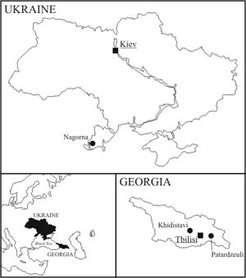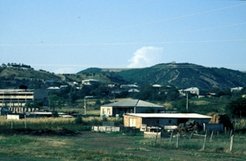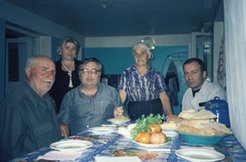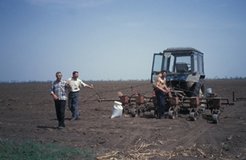Land reform in two former republics of the Soviet Union: Georgia and Ukraine

The Ukrainian information provided below is based on a year's fieldwork carried out over the period (2000-2004). It constitutes part of my ongoing research in a village in the Odessa region. The Georgian information is based on a two week exploratory research trip to Georgia in September 2002. During this time I conducted lengthy interviews with a number of leading figures in the land reform process in Tbilisi. I also twice made day trips to rural areas. As I have conducted no long term fieldwork in Georgia, these findings remain tentative, but are useful in highlighting particularities of the land reform process in Ukraine. Ukraine and Georgia both attained independence in 1991 and initiated land reform during the following year. In Georgia the law transferring land to private ownership was passed in 1996, with registration of titles beginning in 1997. Ukraine followed a similar schedule with legal procedures in place by the mid 1990s although actual conveyance of titles did not begin until 2001. In both countries this process is still underway.
Land Reform in Georgia
The geo-political position of Georgia, lying as is does between the Caspian Sea (the source of oil which is now bought up by western companies) and western Europe, has given the country considerable strategic importance. As a consequence Georgia receives millions of dollars in aid, a fact which has had direct repercussions for land privatisation issues: while the government makes the laws concerning the land, it is NGOs which implement these laws. One USAID official informed me that 'there has been no state budget for land privatisation for the last 3 years because there are so many foreign donors here that there's no need for the state to set aside money for this'.
By the end of 2002 approximately 25% of all land, or 60% of intensively farmed former kolkhoz and sovkhoz land, had been transferred to private ownership. Land is distributed according to criteria of both work and residence. Thus ex-kolkhoz and sovkhoz workers are entitled to a maximum of 1.25 ha of land, village residents working in the non-agricultural sector (eg. teachers) are entitled to 0.75 ha, while citizens not resident in the village but with rural connections are entitled to 0.25 ha. In each case the entitlement figure is higher if the location of the village is in the less fertile mountainous areas. In principle, these criteria of entitlement do not vary significantly from the Ukraine case. But in Georgia a further factor comes into play: land ownership was granted to a household rather than to a family or an individual. This is problematic because 'household' is not defined in Georgian legislation, nor is it legally clear how a person should become or give up membership in a household. Family is defined in the legal code as a couple and their children. Although in most rural cases a family and household are equivalent, this is not necessarily so, and it is possible that in a multi-generational household, the elderly parents might have legally separated, thus constituting a separate household. It is on the basis of local household books in the village that ownership is ultimately determined. If a household consists of a husband, wife and children, they have one land title, even if both adults worked in the previous collectives.
Much of the land is still not transferred into private ownership; meadows and pastures, for example, remain in state ownership. Ltd's were formed from the collectives (often now owned by previous ex-heads) and they are frequently the leasers of the land. While some of the previous facilities remain in their possession, much of the technology has reportedly been stolen or is old. Local committees decide how such common land is used and pro-reformers in Tbilisi point out that this land is often badly managed and at the centre of corruption charges.
Land reform in two former republics of the Soviet Union: Georgia and Ukraine
Case Study
In the Kaheti Region (east Georgia), I visited the village of Patardzevli, in the district of Sakarego. This village has 1578 households (with a total population of approximately 3 000). The total land of the village is 4 000 ha, of which 1381 ha are? already privatised. Thirty five percent of the land comprises pasture and meadow which remain in state ownership. There are no collective farms in the village. A large proportion of the pastoral land is available for lease and, on paper at least, it appears that farmers have formed several groups for the purposes of jointly leasing land. But the DFID (UK Department for International Development) guide, who accompanied me on this trip and has insider information about the village through kinship ties, assured me that in reality one or two individuals are behind the leasing of big tracts of land.

Recognising the problems associated with a lack of resources for the collective working of the land (no capital, no storage or other building facilities, no technology, no informational support and so on) the DFID programme in the village is establishing a farmers' association. The association consists of 20 households - mostly connected through kinship ties - who have pooled their 1 ha plots to create the association's land, while retaining the 0.25 ha surrounding their houses for personal cultivation. In 2002, DFID funds bought the group high grade wheat and a second-hand tractor. The project stipulated that this first group must, in the following year, give enough seed to another group of 20 who would be encouraged to join and work their land together. Through such a 'rollover' arrangement, it is hoped that the previous fragmentation of plots worked by individual households with no resources of their own will be overcome. The first group harvested its first crop of wheat in the autumn of 2002. It was not a good year, due to being uncharacteristically dry, but the group fulfilled its responsibilities to a second group. The head of the association, who used to work in an oil drilling station, told me that the harvest would not be sufficient for his household's needs (which consisted of himself and his wife); that is, it would not provide enough to feed his one pig, one cow and 10-15 chickens.

There are clearly many problems associated with land privatisation in Patardzevli: there is a high degree of fragmentation of land (of which the vast majority is used for subsistence farming); a lack of technology and investment in agriculture; corruption in the leasing process of common land; and the absence of a clearly defined concept of the 'household' in legislation which makes future issues of land sales and inheritance a potential disaster area, especially since current law assumes that the land is co-owned by all household members. The most serious problem in Georgia appears to be the lack of infrastructure which would enable the collective working of the land. In both rural areas I visited in Georgia, land is worked by households not collectives - and officials inform me that this situation is replicated throughout the country. This was dramatically emphasised to me in the village of Khidistavi (close to the town of Gori, the birth place of Stalin), once a thriving centre but now suffering a high level of unemployment. People underlined the lack of resources by saying: 'We work with our hands'. The NGOs response to this problem is either to encourage the development of unions or associations of farmers, or to argue for the necessity of consolidating land plots through sales that inevitably will drive many villagers off the land.
Land reform in two former republics of the Soviet Union: Georgia and Ukraine
Land Reform in Ukraine
Entitlement to land in Ukraine was also determined by type of previous employment: kolkhoz/sovkhoz or in the non-agricultural domain of the village.
The amount of land received by ex-kolkhoz/sovkhoz workers varies from place to place depending on the amount of land and number of members in the former agricultural collective. In the district capital of Reni, ex members received 7 ha, in village Nagorna less, since land there is less plentiful. A national limit for non-agricultural rural workers was set at a maximum of 2 ha. Unlike in Georgia, however, in Ukraine entitlement is not complicated by household issues. It is individuals who are entitled to this land. The number of titles owned by a household depends on the number of people in the house and where they worked. Apart from the privatisation of kolkhoz and sovkhoz land, villagers are also entitled to a maximum of 1 ha for the purposes of a household plot.
Land in Ukraine is worked collectively: most often by cooperatives that have developed from the liquidated kolkhozy and sovkhozy but also by informal groups of non-agricultural rural workers. Private farmers rent land from family and non-family villagers, attracting land owners by offering more lucrative rent than the cooperatives.
Case Study
The village of Nagorna, Odessa Oblast, has a population of 3642 and approximately 1000 houses with a total land area of 7237 ha. In Nagorna five cooperatives have replaced the Soviet collectives, with ex-kolkhoz members receiving 3.45 ha and former sovkhoz workers 4.10 ha. Non-agricultural workers with 0.5 ha each have formed a number of informal groups. There are also approximately 10 private farmers who rent land from other villagers. The farm sizes vary; the largest is approximately 170 ha. In my other comparative project I give an example of a private farmer in Nagorna . Here I give the example of a cooperative.

Currently the overwhelming majority of Nagorna land is worked by successor enterprises to the collective farms. Indeed for most villagers it makes no economic sense to start farming one's own land: the costs are too high, technology too expensive and the land not enough. The former kolkhoz is now four private cooperatives. All four cooperatives are involved in crop production, mainly grains, and are expanding their vineyards; livestock from the previous kolkhoz was liquidated. The previous head of the kolkhoz runs one of the cooperatives called 'Avante Gard' (the head agriculturalist, the previous head engineer run two of the others). It has 176 members and cultivates 440 ha of land. The leader of Avante Gard works closely with two of the other cooperative leaders (the fourth remains aloof and independent). The three leaders take decisions concerning planting jointly, and buy seeds and fuel together. Most of the machinery - tractors, combines and so on - has been preserved, and although old is still in working order. Members are paid the same amount of annual rent, which amounts to approximately 1 tonne of a variety of grains (predominantly wheat), but is dependent on the harvest in any particular year.
Problems in the Ukrainian case vary, depending on the type of organisation. Cooperative members complain that the organisations are not run democratically. Members accuse cooperative leaders of mismanagement of resources and indeed controls are hard to enforce given the fact that the leaders form a closed, elite group. There are clear tensions between the three heads who share the same work practices, and the fourth, who pays his members a different rent, inevitably causing friction between villagers.
Land reform in two former republics of the Soviet Union: Georgia and Ukraine
Conclusion
This comparative sketch points to differences that warrant further study. Despite the same general patterns of privatisation occurring in both countries in a similar time framework, the situation on the ground appears quite different. The most notable feature is the collaborative way in which land is worked in the Ukraine case in contrast to the more individual and fragmented pattern of agricultural production evident in Georgia. This can, in part, be accounted for by simple demographic factors - households in Nagorna own far more land than in the Patardzevli case.
It is clear too that resistance to privatisation by local and regional officials in the Ukraine case has hindered the pace of implementation. The retention of power by local collective leaders, and of the cooperative infrastructure, has contributed to the maintenance of a cooperative working of the land. In Georgia, on the other hand, the fragmentation of land holdings combined with the destruction of cooperative infrastructure has left villagers with no alternative to farming at the household level. Thus, while most would acknowledge the many problems Ukraine has faced in the reforms, the continuation of a collective working of the land, in often new variants, provides some sort of ongoing security as well as a solid basis for the further development of agricultural production.



